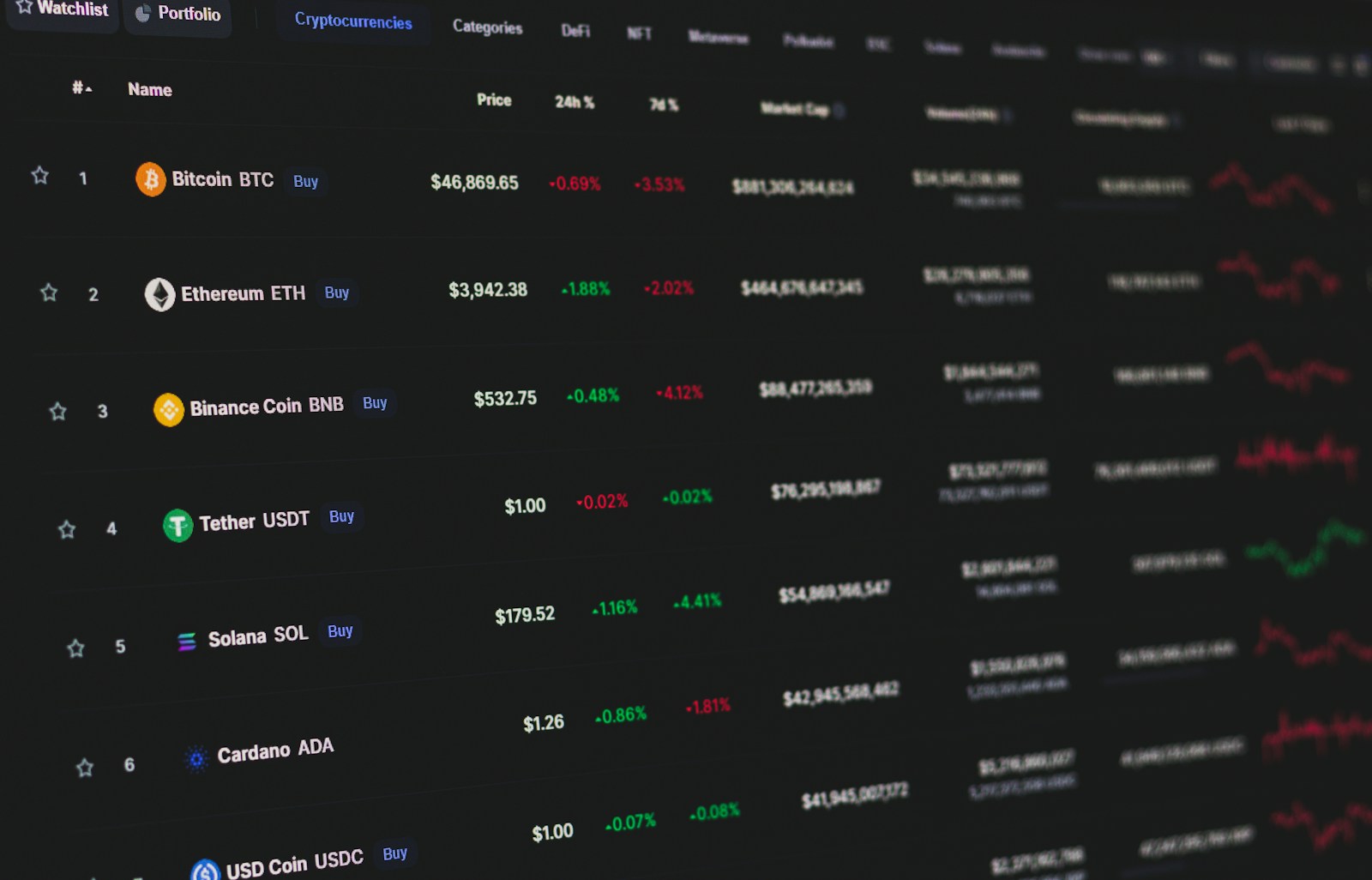
Diversification within cryptocurrency portfolios has gained momentum as investors seek options beyond the predominant digital asset. More than 20,000 tokens currently exist, with several projects showcasing unique technology and use cases that challenge traditional payment or store-of-value models. For example, Ethereum’s smart contract functionality powers decentralized finance (DeFi) platforms handling billions in value daily, illustrating innovation that extends past simple transactions.
The surge in altcoins reflects a broader spectrum of investment opportunities driven by specialized protocols addressing scalability, privacy, or governance. Coins like Solana and Avalanche offer high throughput solutions surpassing older networks’ speeds and fees, attracting both developers and institutional capital. Meanwhile, privacy-focused assets such as Monero prioritize anonymity features unavailable on many mainstream chains.
Current market dynamics highlight how emerging cryptocurrencies serve distinct niches rather than just replicating existing functions. This diversity provides investors with tailored exposure to specific sectors–gaming tokens powering NFTs or stablecoins ensuring price stability amid volatility. Evaluating these alternatives requires understanding their underlying consensus mechanisms, adoption metrics, and community support to gauge long-term viability effectively.
Cryptocurrency alternatives presenting notable investment prospects
Emerging projects beyond the original decentralized currency have introduced diverse technical innovations, offering investors multiple avenues for portfolio diversification. Notably, networks like Ethereum utilize smart contracts to automate complex transactions without intermediaries, expanding functionality far beyond simple value transfer. This shift from basic transaction protocols to programmable finance highlights a key innovation driving interest in non-primary digital assets.
The ecosystem’s breadth includes platforms optimized for scalability and privacy enhancements. For example, Solana employs a proof-of-history consensus mechanism enabling throughput of over 50,000 transactions per second, addressing latency issues common in earlier models. Meanwhile, Monero integrates advanced cryptographic techniques such as ring signatures and stealth addresses to ensure transaction anonymity, catering to users prioritizing confidentiality over transparency.
Diversity of technological approaches shaping current digital asset options
Investment decisions hinge on understanding the foundational differences between various blockchain architectures and their intended use cases. Cardano adopts a research-driven approach with peer-reviewed protocols emphasizing formal verification to enhance security and sustainability. In contrast, Binance Smart Chain provides compatibility with existing development tools while delivering faster finality times compared to older platforms, appealing to decentralized application developers seeking practical deployment environments.
Each initiative introduces unique tokenomics and governance models influencing market dynamics. Projects like Polkadot focus on interoperability by enabling cross-chain communication through relay chains, facilitating asset transfers across independent networks. Such architectural choices broaden utility but also introduce complexity affecting liquidity and adoption rates–factors critical in evaluating long-term viability.
Analyzing recent market performance reveals that certain projects with specialized functionalities outperform general-purpose currencies during specific cycles. For instance, DeFi-focused tokens often experience surges correlated with rising demand for decentralized lending or yield farming services. This pattern underscores the importance of aligning investment strategies with evolving sector trends rather than relying solely on legacy prominence or market capitalization metrics.
Ultimately, selecting among these cryptocurrency contenders requires balancing innovation potential against technical maturity and regulatory considerations. While novel consensus algorithms or privacy features can enhance network capabilities, they may also face integration challenges or compliance scrutiny affecting user trust and institutional adoption. Continuous monitoring of protocol upgrades, developer activity, and community engagement provides critical insights into each option’s trajectory within an increasingly competitive environment.
Top altcoins by use case
The diversity of blockchain projects today offers multiple investment options beyond the primary cryptocurrency. Each project leverages unique technology to address specific challenges, creating specialized ecosystems that extend far past simple value transfer. For instance, Ethereum’s smart contract platform remains pivotal for decentralized applications (dApps), enabling programmable logic execution and tokenization on a global scale. Its ongoing transition to Proof-of-Stake consensus enhances scalability and energy efficiency, positioning it as a robust alternative for developers seeking flexibility and security.
Another noteworthy project is Chainlink, which excels as a decentralized oracle network. It connects blockchains with real-world data feeds, enabling smart contracts to interact securely with external APIs and data sources. This innovation expands the functional scope of blockchain technology into industries such as finance, insurance, and supply chain management. Chainlink’s reliable data provision addresses the critical issue of off-chain information trustworthiness, making it an attractive option for enterprises integrating blockchain solutions.
Sector-specific innovations: DeFi, privacy, and scalability
Decentralized Finance (DeFi) platforms like Aave illustrate how altcoins facilitate entirely new financial services without traditional intermediaries. Aave provides lending and borrowing protocols governed by smart contracts, allowing users to earn interest or obtain liquidity through collateralized loans. With over $10 billion locked in its protocol as of mid-2024, Aave demonstrates tangible adoption driven by technological innovation rather than speculative hype. This use case highlights how altcoins diversify financial infrastructure by offering programmable money capabilities.
Privacy-focused projects contribute another layer of technological advancement. Monero employs ring signatures and stealth addresses to obfuscate transaction details, ensuring user anonymity at the protocol level. This contrasts sharply with transparent ledgers used elsewhere in the ecosystem. Such privacy-centric altcoins cater to sectors requiring confidentiality in transactions and have found niche but steady demand despite regulatory scrutiny. Their specialized cryptographic techniques showcase an important dimension of blockchain versatility.
Scalability remains a fundamental concern addressed by various networks through different mechanisms. Solana utilizes a novel Proof-of-History consensus combined with Proof-of-Stake to achieve transaction speeds exceeding 65,000 per second while maintaining low fees. This throughput capability supports complex dApps including NFTs and gaming platforms where user experience depends heavily on responsiveness and cost-efficiency. Investors interested in performance-driven projects often consider Solana due to its technical approach balancing decentralization with speed.
Finally, interoperability-focused projects like Polkadot introduce multi-chain frameworks enabling seamless communication between independent blockchains. By facilitating cross-chain transfers of assets and data via parachains secured under a shared relay chain consensus model, Polkadot enables composability across diverse ecosystems previously isolated from each other. This architectural innovation broadens the potential application scenarios for decentralized technologies and provides strategic options for developers aiming to integrate heterogeneous networks efficiently.
How to Choose Altcoins Safely
Prioritize projects with transparent technology and active development teams. Evaluating the underlying blockchain protocols is critical: for example, coins utilizing proof-of-stake consensus mechanisms, such as Cardano (ADA), demonstrate significantly lower energy consumption compared to proof-of-work systems. Investigate GitHub repositories or equivalent codebases to confirm ongoing innovation and recent commits, which often correlate with project vitality and resilience against obsolescence.
Diversity in investment options mitigates risk inherent in this sector. Allocating capital across various altcoins that serve distinct use cases–ranging from decentralized finance (DeFi) platforms like Aave (AAVE) to privacy-focused networks such as Monero (XMR)–can balance exposure while tapping into multiple technological innovations. Consider market capitalization alongside liquidity; coins under $100 million may offer higher returns but lack stability, whereas mid-cap projects present more predictable growth trajectories due to broader adoption.
Technical Evaluation Criteria
Assessing scalability solutions is paramount when selecting alternative digital assets. Projects implementing layer-2 solutions or sharding techniques–like Polygon’s sidechains–offer enhanced throughput without compromising decentralization. Additionally, interoperability features enabling seamless communication between blockchains elevate a project’s long-term viability; Polkadot (DOT) exemplifies this by facilitating cross-chain transfers through its relay chain architecture. Scrutinize whitepapers for clear descriptions of consensus algorithms, tokenomics models, and governance frameworks that incentivize network participation and security.
Real-world case studies reveal the importance of community engagement and regulatory compliance. For instance, Solana’s rapid rise was fueled not only by high transaction speeds but also by developer incentives encouraging ecosystem expansion. Meanwhile, projects facing legal scrutiny tend to experience price volatility and hindered innovation cycles. Therefore, tracking partnerships with established enterprises or integration in mainstream financial services can signal robust infrastructure and potential for sustained growth within diverse investment portfolios.
Conclusion: Strategic Approaches to Trading Emerging Cryptocurrency Projects
Prioritizing projects with demonstrable technological innovation and robust development teams enhances the probability of sustainable returns in altcoin trading. For instance, Layer 2 scaling solutions like Polygon have exhibited significant growth by addressing Ethereum’s throughput limitations, proving that evaluating underlying technology is critical when selecting investment options.
Risk management strategies tailored to volatility inherent in alternative cryptocurrencies should integrate both on-chain analytics and market sentiment indicators. Tools such as Whale Alert and Glassnode provide actionable insights into large transactions and network health, enabling traders to anticipate momentum shifts before they reflect in price action.
Key Technical Insights and Future Outlook
- Diversification within niche sectors: Allocating capital across decentralized finance (DeFi), non-fungible tokens (NFTs), and privacy-focused coins can mitigate sector-specific risks while capturing varied innovation trajectories.
- Algorithmic trading algorithms: Employing machine learning models trained on granular blockchain data can identify arbitrage opportunities among correlated altcoins, optimizing entry and exit points beyond manual analysis capabilities.
- Governance token dynamics: Understanding voting power distribution and protocol upgrade schedules is increasingly vital, as governance decisions directly impact project viability and token valuation.
The expanding ecosystem of cryptocurrency alternatives demands continuous adaptation of trading methodologies that incorporate both fundamental project evaluation and quantitative metrics. Anticipate increased integration of cross-chain interoperability protocols facilitating seamless asset transfers; this will create novel arbitrage possibilities but also require sophisticated multi-chain monitoring systems.
Ultimately, successful engagement with these innovative investment vehicles hinges on a nuanced comprehension of evolving technology stacks alongside vigilant market analysis. Are current models sufficiently agile to capture emerging trends shaped by regulatory shifts or macroeconomic factors? Maintaining a forward-looking stance will distinguish proficient traders amidst intensifying market complexity.








